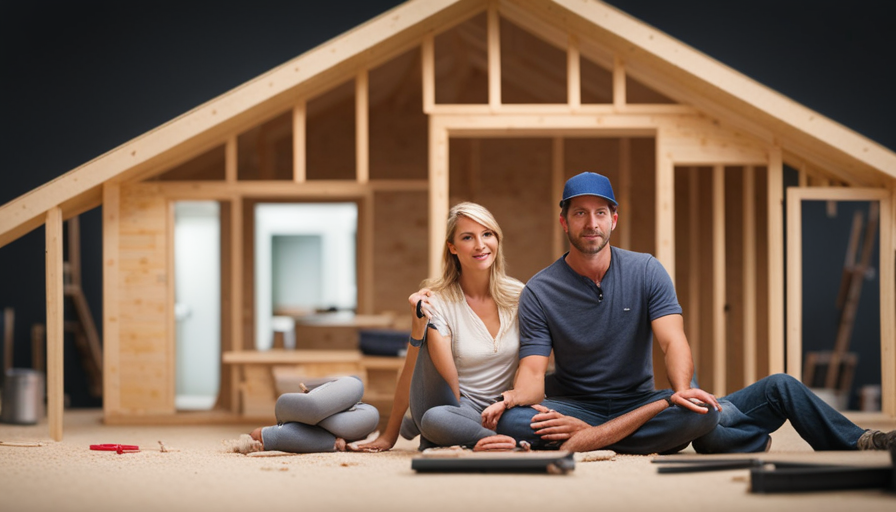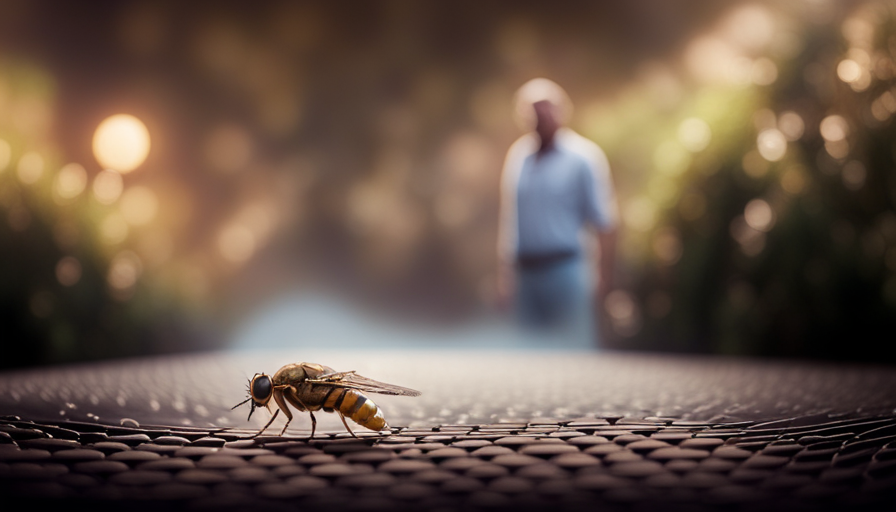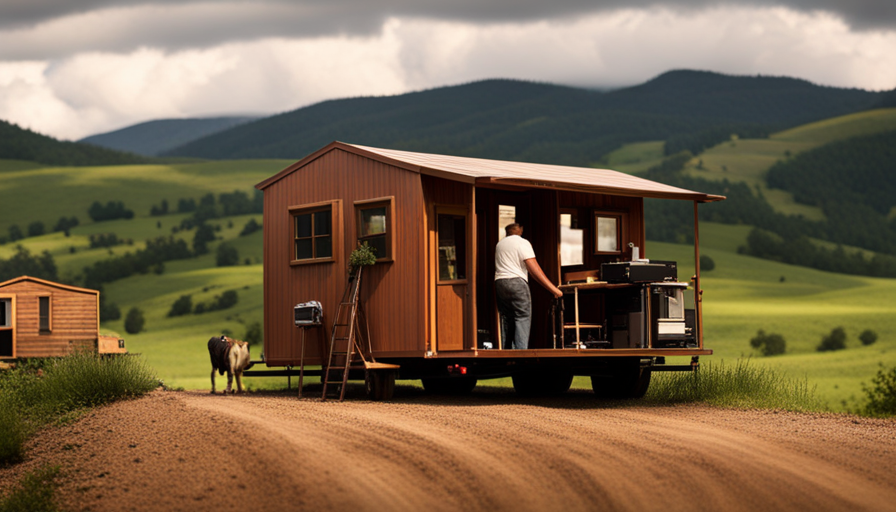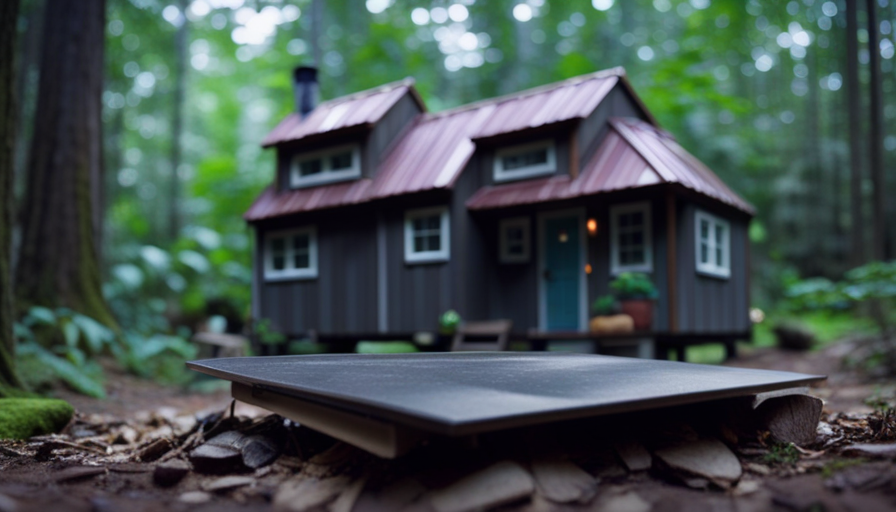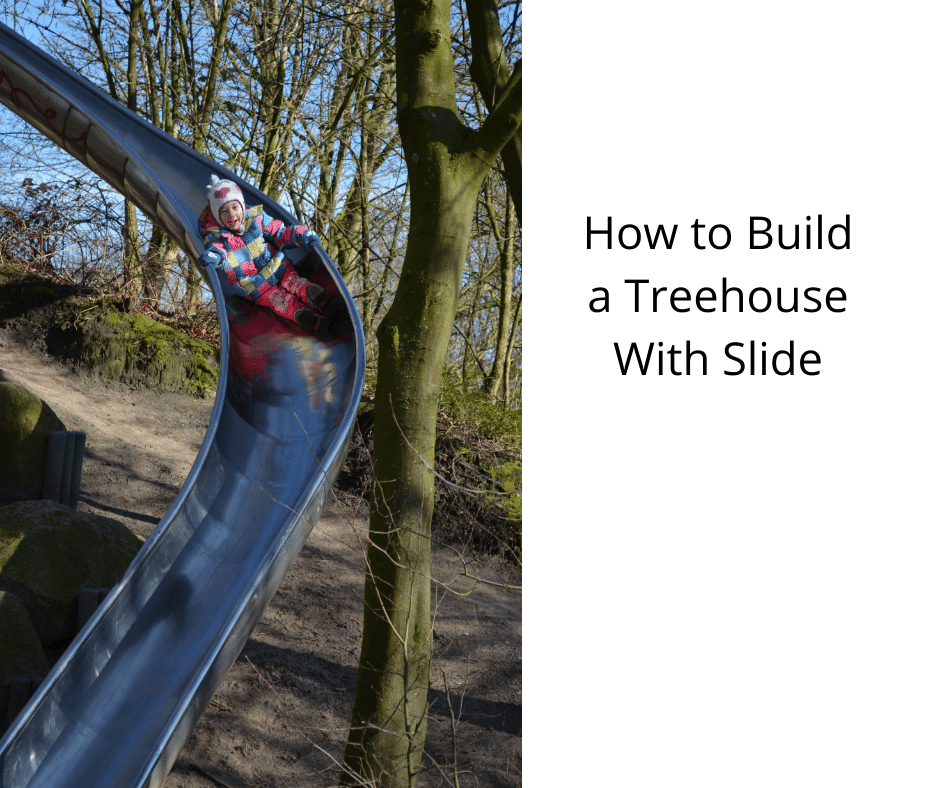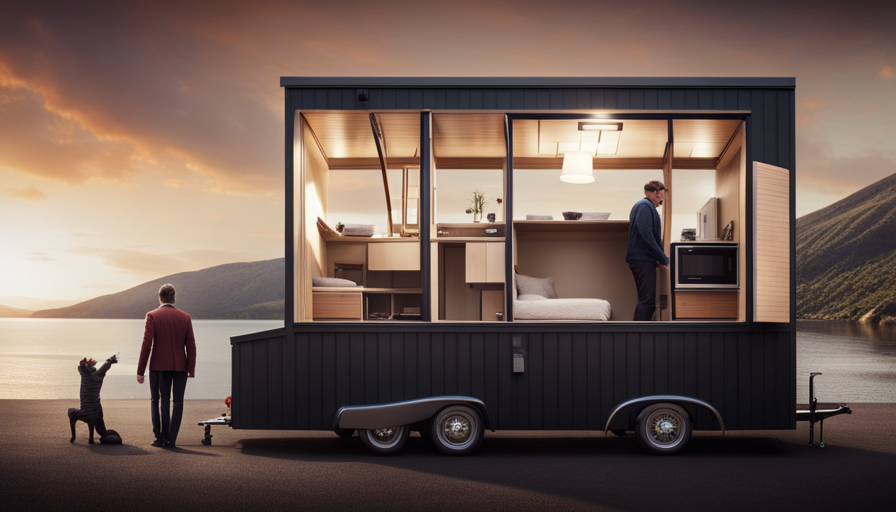Building a small house is like solving a complex puzzle, carefully arranging each piece to create a cozy and functional living space. It requires thorough planning, precise measurements, and a keen eye for detail to maximize every square inch.
If you’re ready to embark on the journey of building your own tiny house, you’re in luck! In this article, I will guide you through the process of building a tiny house using free plans. From designing your tiny house to incorporating sustainable features, from plumbing and electrical considerations to interior design and décor, I will provide you with all the information you need to create your dream tiny home.
Whether you’re a DIY enthusiast or simply looking to downsize and simplify your life, these free plans will help you create a space that is not only functional but also aesthetically pleasing.
So let’s get started on this exciting and rewarding adventure of building your own tiny house!
Key Takeaways
- Careful planning, precise measurements, and maximizing space are crucial when building a tiny house.
- Space-saving furniture ideas and essential storage solutions should be considered in the design process.
- Lightweight and sturdy materials like steel or wood are recommended for the structural integrity of the house.
- Incorporating sustainable features such as reclaimed wood and solar panels can enhance the living experience and reduce ecological footprint.
Designing Your Tiny House
Now that you’ve got the basics down, it’s time to let your imagination run wild and start designing your dream tiny house.
When it comes to designing a tiny house, space is at a premium, so it’s important to make every square inch count. One of the key elements to consider is space-saving furniture ideas. Look for multi-purpose furniture that can serve multiple functions, such as a sofa that can also be used as a bed or a dining table that can fold up against the wall when not in use.
Additionally, essential storage solutions are a must. Think about incorporating built-in shelving, hidden storage compartments, and clever organization systems to maximize your space.
With these design elements in mind, you can create a functional and efficient tiny house that meets all your needs.
Now, let’s dive into the next section and start building your tiny house.
Building Your Tiny House
Imagine creating your very own cozy and compact dream home, tailored specifically to your needs and desires. When building your tiny house, the designing layout and choosing materials are crucial steps to ensure functionality and durability.
Start by carefully considering the layout of your tiny house, taking into account your daily activities and how you want to utilize the space. Make sure to include essential areas such as a kitchen, bathroom, sleeping area, and storage. Additionally, it’s important to choose materials that are lightweight yet sturdy, such as steel or wood, to ensure the structural integrity of your tiny house. Consider using sustainable and eco-friendly materials to reduce your environmental footprint.
By carefully designing the layout and selecting the right materials, you can create a beautiful and functional tiny house that meets your needs.
Now, let’s explore how to maximize the limited space in your tiny house.
Maximizing Space in Your Tiny House
When creating your compact dream home, finding clever ways to maximize space is as essential as finding a needle in a haystack. To make the most of your tiny house, consider incorporating space-saving furniture and following organization tips.
Multi-purpose furniture, such as a sofa that transforms into a bed or a dining table that extends when needed, can help maximize functionality without taking up unnecessary space. Utilizing vertical storage solutions, like wall-mounted shelves and hanging organizers, can also free up valuable floor space.
Additionally, creating designated storage areas for specific items, such as a built-in shoe rack or a hidden storage compartment under the stairs, can help keep your tiny house clutter-free. By implementing these space-saving strategies, you can ensure that every square inch of your tiny house is utilized efficiently.
Now let’s explore how to incorporate sustainable features into your compact home.
Incorporating Sustainable Features
To truly maximize the potential of your compact dream home, consider incorporating sustainable features that not only benefit the environment but also enhance your living experience.
When it comes to building a tiny house, using sustainable materials is crucial. Opt for materials like reclaimed wood, bamboo, or recycled metal for construction. These options not only reduce the demand for new materials but also add a unique and eco-friendly touch to your tiny house design.
Additionally, off-grid living is a great way to minimize your ecological footprint. Install solar panels to generate electricity and use rainwater collection systems for water supply.
Finally, consider implementing a composting toilet to reduce water usage and create nutrient-rich soil.
By incorporating these sustainable features, you can create an environmentally-friendly and efficient tiny house that meets your needs.
Now, let’s delve into plumbing and electrical considerations.
Plumbing and Electrical Considerations
You can’t forget about the plumbing and electrical considerations when designing your sustainable compact paradise. Proper plumbing installation and electrical wiring are essential for a functional and safe tiny house. When it comes to plumbing, you need to carefully plan the layout and choose the right materials to ensure efficient water flow and waste disposal. This includes installing a water supply system, drainage system, and bathroom fixtures. As for electrical considerations, it is crucial to consult a professional electrician to ensure compliance with safety codes and regulations. You need to design a proper electrical layout, including outlets, switches, and lighting fixtures, while also considering energy-efficient options. By carefully considering these plumbing and electrical aspects, you can create a tiny house that is not only sustainable but also comfortable and functional. Moving on to the next section about interior design and décor, it is important to create a cohesive and aesthetically pleasing space that reflects your personal style.
Interior Design and Décor
Now that we’ve considered the plumbing and electrical aspects of building a tiny house, it’s time to focus on the interior design and décor.
When it comes to tiny house furniture, maximizing space is essential. Opt for multi-functional pieces like a sofa that can transform into a bed or a dining table that can double as a workspace.
To create the illusion of a larger space, choose light and neutral color schemes for small spaces. Whites, creams, and pastels can make your tiny house feel more open and airy. Additionally, strategically placed mirrors can help reflect light and make the space appear larger.
Don’t forget to add your personal touch with decorative accents and artwork that reflect your style and personality.
With the interior design complete, it’s time to move on to the next section, where we’ll explore the joys of living in your tiny house.
Living in Your Tiny House
Imagine waking up in your cozy sanctuary, surrounded by the simplicity and tranquility of your tiny house. Living in a tiny house offers a unique and fulfilling lifestyle. Here are four reasons why it’s worth considering:
-
Strong Sense of Community: The tiny house community is a tight-knit group of like-minded individuals who share a passion for minimalistic living. You’ll have the opportunity to connect with people who value sustainable living and support one another.
-
Financial Freedom: With lower costs for utilities, maintenance, and mortgage payments, living in a tiny house allows you to save money and reduce financial stress. You’ll have more flexibility to pursue your passions and live life on your terms.
-
Minimal Environmental Impact: Tiny houses have a significantly smaller carbon footprint compared to traditional homes. By living in a tiny house, you’ll be contributing to a more sustainable future and minimizing your impact on the environment.
-
Zoning Regulations: While zoning regulations can vary, many communities are recognizing the benefits of tiny houses and are adopting more lenient regulations. This opens up more opportunities for finding a suitable location to park your tiny house and enjoy the lifestyle you desire.
Living in a tiny house offers a sense of community, financial freedom, environmental sustainability, and the potential to find a suitable location within zoning regulations. Embrace the simplicity and tranquility that comes with this unique lifestyle.
Frequently Asked Questions
Can I legally build a tiny house in my area?
Legally building a tiny house in my area depends on the specific zoning regulations and building permits. Like a tightrope walker cautiously navigating the wire, understanding these rules is crucial.
Zoning ordinances determine if tiny houses are allowed in certain areas, while building permits ensure that construction meets safety standards. Researching local codes and consulting with authorities helps ensure compliance and avoid legal issues. Remember, compliance is key to a successful tiny house project.
How much does it typically cost to build a tiny house?
The cost range to build a tiny house can vary depending on several factors. Factors influencing cost include the size of the house, the materials used, and whether you choose to hire professionals or do the work yourself.
On average, the cost to build a tiny house can range from $20,000 to $100,000. However, it’s important to note that these estimates can vary greatly based on individual preferences and location.
Are there any specific building codes or regulations that I need to follow when constructing a tiny house?
When constructing a tiny house, it’s crucial to adhere to building code requirements and zoning regulations. Building codes dictate the minimum standards for safety and structural integrity, including specifications for electrical, plumbing, and insulation systems.
Zoning regulations vary by location and govern how the land can be used, including requirements for setbacks, size restrictions, and permitted uses. Familiarizing yourself with these regulations is essential to ensure compliance and avoid potential legal issues.
What are some common challenges faced when designing and building a tiny house?
Designing and building a tiny house can be a challenging endeavor. Budget constraints often require careful planning and resourcefulness to ensure every penny is well-spent.
Space optimization is crucial, as limited square footage requires creative solutions for storage and multi-purpose functionality.
Adhering to building codes and regulations adds another layer of complexity. However, with proper research, problem-solving skills, and attention to detail, these challenges can be overcome, resulting in a beautiful and functional tiny house.
Are there any financing options available for building a tiny house?
Financing options for building a tiny house include various loan options. These options provide individuals with the necessary funds to cover the costs associated with constructing a tiny house.
Loan options may include personal loans, home equity loans, or specialized loans for tiny house construction. Personal loans offer flexibility, while home equity loans utilize the value of an existing property. Specialized loans cater specifically to tiny house projects and often have unique terms and requirements.
Conclusion
In conclusion, building a tiny house is a meticulous process that requires careful planning and execution. From designing the layout to incorporating sustainable features, every step must be taken with utmost precision. Maximizing space is essential in these compact dwellings, and plumbing and electrical considerations can’t be overlooked.
And let’s not forget the importance of interior design and décor to make your tiny house feel like a home. So, if you’re up for a challenge and enjoy the thrill of living in a space the size of a shoebox, then building a tiny house might just be your cup of tea.
Happy downsizing!
Hi, I’m Emma. I’m the Editor in Chief of Tiny House 43, a blog all about tiny houses. While tree houses are often associated with childhood, they can be the perfect adult retreat. They offer a cozy space to relax and unwind, surrounded by nature. And since they’re typically built on stilts or raised platforms, they offer stunning views that traditional homes simply can’t match. If you’re looking for a unique and romantic getaway, a tree house tiny house might just be the perfect option.
